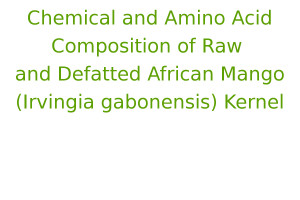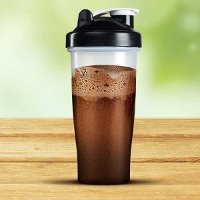Ekiti State University, Department of Chemistry P.M.B 5363, Ado Ekiti, Ekiti State, Nigeria.
The results of research on "Chemical and Amino Acid Composition of Raw and Defatted African Mango (Irvingia gabonensis) Kernel" conducted by Ogungbenle Henry Niyi (British Biotechnology Journal, ISSN: 2231-2927,Vol.: 4, Issue.: 3 (March)).
The proximate, mineral, functional properties, anti-nutrients and amino acid compositions of African mango (Irvingia gabonensis) seeds have been investigated. The results showed that seeds contained ash (2.49 g/100g), moisture (5.79 g/100g), protein (10.64 g/100g), fat (54.67 g/100g), fibre (8.35g/100g) and carbohydrate (18.67 g/100g). The predominant mineral was magnesium (54.53 mg/kg). Water absorption, oil absorption and oil emulsion capacities were relatively high while foaming capacity and least gelation concentration were low.
1. INTRODUCTION
The discovery of some of underutilized fruits, vegetables and other plants derivatives used as human food is constantly receiving the attention of scientists. The rural dwellers depend on wild fruits to meet their daily food needs. Some of these fruits and vegetables provide daily energy, protein and vitamins to alleviate malnutrition and incessant sickness. An example of one of such seeds is that of the African mango sometimes known as wild mango[1][2]. African mango grows in the tropical and subtropical forests of central and West Africa.
This tree is found in an evergreen forest and mixed deciduous forest. The tree can attain a height up to 35m (100ft) and its fruits are 4 to 7 cm in diameter and yellow at maturity. The pulp, kernel and fruit are said to be eaten by man and animal. The kernel of the fruits is very rich in oil. Its fruit resembles a small mango. In Nigeria, the Yorubas refer to it as ‘Oro’ and the kernel is known as ‘Apon’, the Igbos call the kernel as ‘ogbono’ which is popularly known for making soup called ogbono soup. In Ghana, it is popularly known as ‘Ato’ because of its excellent nutritional value, the fruits are often used for preparing food dishes. The seed is widely consumed and produced in African countries most especially in Nigeria by local farmers. The purpose of this study is to determine the proximate, minerals, anti nutrient, functional properties and amino acids of both raw and defatted African mango (Irvingia gabonensis). The rationale behind defatting the sample is just to create room for comparison and also to know if defatting can actually improve or inhibit the nutritional properties of the sample. The data obtained may serve as control, contradict and also as additional information to available data.
2. MATERIALS AND METHODS
The African mango (Irvingia gabonensis) seeds used for this study were bought from a central market in Ado-Ekiti, South West of Nigeria in Africa continent. The seeds were sun dried and later ground into fine flour and stored in an air tight polyethylene bag prior to analyses. The defatting process was carried out using soxhlet extractor. The raw sample flour (50g) was refluxed severally for 7 hours until fat was removed using petroleum ether as solvent and product obtained after the process was the defatted sample[3].
2.1 Proximate Analysis
The moisture and ash contents determined using the air oven and dry ash method[4]. The sample was analyzed for crude fat and crude protein according to the methods described by[3]. Nitrogen was determined by micro-Kjedahl method described by[3] and the percentage nitrogen was converted to crude protein by multiplying by 6.25. The crude fibre was determined by adding 2g (W1) of the sample into 500ml conical flask; 200ml of boiling 1.25% of H2SO4 was added and boiled for 30minutes. The mixture was filtered through muslin cloth and rinsed with hot distilled water. The sample was scrapped back into the flask and 200ml of boiling 1.25% NaOH was added and allowed to boil again for another 30 minutes; filtered and then rinsed with 10% HCl twice with industrial methylated spirit and allowed to drain and dry. The residue was scrapped into a crucible, dried in the oven at 105ºC, allowed to cool in a desicator and weighed (W2); then placed in muffle furnace at 300ºC for 30 minutes and finally allowed to cool at room temperature and weighed again (W3).
(1)
\[ \%\ crude\ fibre = \frac{{W_2}-{W_3}}{W_1}\ x\ 100 \]
The carbohydrate content was calculated by method of difference.
(2)
\[ \%CHO = \{100 – (\% moisture + \% Ash + \%\ crude\ fibre + \%Crude\ fat + \% Crude\ protein)\} \]
2.2 Determination of Anti-nutrients
Oxalate: 1g of the sample was taken into 100ml conical flask, 75ml of 1.5N H2SO4 was added and the mixture was stirred for 1 hour and then filtered. 25ml of sample filtrate was titrated against 0.1NKMnO4 solution until faint color persisted for 30 seconds[5].
Tannins: 200mg of the sample was added to 10ml of 70% aqueous acetone and properly covered. The mixture was put in an ice bath and shaken for 2hours at 30ºC. The mixture was later centrifuged at 3,600rpm; 0.2ml of the mixture was pipetted into test tubes and 0.8ml of distilled water was added. Standard tannic acid solutions were prepared from a 0.5mg/ml stock and the solution made up to 1ml with distilled water. 0.5ml Folin reagent was added to both sample and standard solution and then followed by the addition of 2.5ml of 20% Na2CO3. The solutions were then vortexed and allowed to incubate for 40minutes at room temperature after which absorbance was measured at 725nm[5].
Phytate was determined on Spectronic 20 colorimeter (Gallenkamp,UK) using the method described[6][7]. The amount of phytate in the sample was calculated as hexaphosphate equivalent using the formula:
(3)
K X A X 20/0.282 X1000
Where A is the absorbance, mean K = standard P.
Phytate = 28.2% P
2.3 Mineral Analysis
The minerals were analyzed by dry ashing the sample at 550ºC to constant weight and dissolving the ash in 100 ml standard flask using distilled deionized water with 3ml of 3M HCl. Sodium and potassium were determined by using a flame photometer (model 405, corning, U.K). All other minerals were determined by Atomic Absorption Spectrophotometer (Perkin and Elmer model 403, USA).
2.4 Determination of Functional Properties
The water and oil absorption capacities of the sample were determined using the method[8]. 10cm3 of water was added to 1.0g sample in a centrifuge tube. The suspension was mixed vigorously using votex mixer. This was then centrifuged at 3500 rpm for 25minutes and the volume of the supernatant left after centrifuging was noted. Water bound was calculated from the difference in the initial volume of the solvent used and the final volume after centrifuging. The same procedure was used for oil absorption capacity but oil replacing water in above process.
The slight modified procedure of[9] was used to determine least gelation concentration. Sample slurries of 2, 4, 6, 8, 10, 12, 14 and 16 were prepared in 5ml of distilled water. The test tubes containing these slurries were heated for one hour in boiling water followed by rapid cooling under running tap water. The test tubes were then cooled for 2hours at 4ºC. The least gelation concentration was determined as concentration which did not fall or slip when the test tubes were inverted. The emulsion capacity and stability determined by[8].
The method[10] was employed to determine foaming capacity and stability. 1g of the sample was whipped with 50ml distilled water for 5 minutes in a Kenwood blender and later poured into a 100ml graduated flask to study the foaming stability (volume increase %). The foaming capacity was calculated according to the following equation.
(4)
\[ Volume\ increase \% = \frac{{volume\ after\ whipping}-{volume\ before\ whipping}}{Volume\ before\ whipping}\ x\ 100 \]
2.5 Determination of Amino Acid
The amino acid profile was determined using the method described[11].The sample was dried to constant weight and defatted using soxhlet extractor, then followed by these processes:
2.5.1 Hydrolysis of sample
Two grammes defatted sample was taken into glass ampoule. 7ml of 6MHCl was added and oxygen was expelled by passing nitrogen into the ampoule (this is to avoid possible oxidation of some amino acids during hydrolysis) e.g methionine and cysteine. The glass ampoule was then sealed with bursen burner flame put in an oven present at 105±5ºC for 22 hours. The ampoule was allowed to cool before broken open at the tip and the content was filtered to remove the humins. The filterate was then evaporated to dryness at 40ºC under vacuum in a rotary evaporator. The residue was dissolved with 5ml of acetate buffer (pH 2.0) and stored in plastic specimen bottles which were kept in the freezer.
2.5.2 Loading of the hyrolysate into TSM analyser
Hydrolysate (7.5µL) was dispensed into the cartridge of the analyser using a syringe. The TSM analyser is designed to separate and analyse free acidic, neutral basic amino acids of hydrolysate. The period of the analysis lasted for 76 minutes. The gas flow rate was 0.50ml/min at 60ºC with reproducibility consistent within ±3%.
2.5.3 Method of calculating amino acid values from the chromagram peaks
The net height of each peak produced by the chart recorder of TSM (each representing an amino acid) was measured. The width of the peak at the half height was accurately measured and recorded. Appropriate area of each peak was then obtained by multiplying the height with the width of half-height.
The norcleucine equivalent (NE) for each amino acid in the standard mixture was calculated using the formula:
(5)
\[ NE = \frac{Area\ of\ Norcleucine\ peak}{Area\ of\ each\ amno\ acid}\]
A constant “s” was calculated for each amino acid in the standard mixture.
(6)
\[ Sstd =\ NE\ std\ X\ Mol.\ Weight\ X\ μ\ MAA\ std \]
Finally, the amount of each amino acid present in the sample was calculated in g/100g
protein using the formula:
(7)
\[ Concentration\ (g/100g\ protein)\ =\ NH\ X\ W\ @\ NH/2\ X\ Sstd\ X\ C \]
(8)
\[ Where\ C = \frac{\frac{Dilution\ X\ 16}{Sample\ wt(g)\ X\ N2%\ X\ 10\ X\ vol.\ loaded}}{NH X W (Nleu)}\]
Where:
NH = Net height
W = Width
Nleu = Norleucine
3. RESULTS AND DISCUSSION
The proximate composition of raw and defatted is presented in Table 1. The moisture content for raw (5.19%) was greater than those for the defatted (4.79%) and Terminalia catappa (4.13%) reported by[12]. These values were low when compared with those of walnut flour reported by[13] and quinoa flour (11.20%) reported by[14]. This low value could be an added advantage to the shelf-life of the defatted flour. The crude fibre levels of the raw and defatted samples were 8.32% and 9.71% respectively. The fibre in defatted was higher than that of raw sample. These values reported were lower than that of bambara groundnut 15.2%[15]. The value of the defatted sample (9.71%) was higher than those of cowpea (3.61%), scarlet runner bean (3.20%) reported by[15], 2.5% Luffa cylindrical[16] and 3.04% African nutmeg[17]. The high fibre content may improve bowel function and provide faecal bulk digestion. The crude fat value of the raw sample was 54.7%. This value qualify African mango as oil-rich when compared with the range of oil-rich legumes (43.8-51.9%) reported by[18] for white melon, gourd seed, benniseed, bulma cotton seed and yellow melon, pumpkin seed ( 47.0%) reported by[19], Adenopus breviflorus 47.67% reported by[20], Tetracarpidium conophorum (50.6%)[21], cucumeropisedulis (43.7%), citrullus vulgaris variety 1 (47.7%), citrullus vulgaris variety 2 (51.1%) and colocynthis citrullus (52.0%)[22]. This high value of the crude fat suggests that the kernel maybe a good source of quality vegetable oil for both domestic and industrial uses. The carbohydrate content in raw sample was 18.7% and 49.2% for the defatted sample. The values of crude protein compared favourably with some legumes such as cowpea (12.1%), kersting’s groundnut (12.9%) and bambara groundnut (11.6%)[23]. The value of the defatted sample (14.8%) was higher than those of some cereals such as pearl millet (11.4%) and quinoa (11.2%) reported by[24].
Table 1. Proximate composition (%) of raw and defatted African mango (Irvingia gabonensis) seeds
| Component | Raw sample | Defatted sample |
|---|---|---|
| Ash | 2.49 | 3.48 |
| Moisture | 5.19 | 4.79 |
| Crude protein | 10.6 | 14.8 |
| Crude fat | 54.7 | 7.96 |
| Crude fibre | 8.32 | 9.71 |
| Carbohydrate (by difference) | 18.7 | 59.2 |
The data on the mineral composition for raw and defatted samples were shown in Table 2. The samples were found to contain appreciable amount of magnesium, potassium, sodium, phosphorus, calcium, zinc, copper, manganese and extremely low level of lead (0.03mg/g). Magnesium was the highest mineral with the value of 48.2mg/g followed by potassium (43.1mg/g) and sodium (30.1mg/g) respectively. The Na/K and Ca/P ratios are nutritionally important. It was observed by[25] that modern diets which are rich in animal proteins and phosphorus may promote the loss of calcium in the urine. This brought about the concept of the Ca/P ratio. If the Ca/P is low (low calcium, high phosphorus) more than the normal amount of calcium may be lost in the urine thereby decreasing the calcium level in bones[26]. Food is considered ‘good’ if the ratio is above one and ‘poor’ if the ratio is less than 0.5[27]. The Ca/P ratio of African mango ranged between 0.60 and 0.91. This indicates that Ca/P ratio of defatted sample was fairly good while that of raw was fair. The ratios of Na/K were raw (0.70) and defatted (0.71). A Na/K ratio of 0.60 is recommended[27]. None of the studied samples had Na/K less than 0.60. These values were little above 0.60 which indicates that they would not promote high blood pressure diseases. The iron levels were found to be in the range of 2.25-5.15%. The iron content of defatted sample studied was comparable with that of Luffa cylindrical kernel (5.3%) reported by[16] but higher than those of 4.58% kidney bean[28], 2.6% quinoa[14] and 3.68% date palm fruit[29]. Iron is very essential in formation of blood.
Table 2. Mineral composition (mg/100g) of raw and defatted African mango (Irvingia gabonensis) seeds
| Minerals | Raw sample | Defatted sample | |
|---|---|---|---|
| Sodium | Na | 30.1 | 36.7 |
| Potassium | K | 43.1 | 51.7 |
| Calcium | Ca | 14.4 | 22.6 |
| Magnesium | Mg | 48.3 | 54.5 |
| Zinc | Zn | 4.30 | 6.73 |
| Iron | Fe | 0.25 | 5.15 |
| Manganese | Mn | 0.33 | 1.21 |
| Copper | Cu | 0.42 | 1.35 |
| Lead | Pb | 0.03 | 0.12 |
| Phosphorus | P | 24.3 | 24.9 |
Table 3 presents the anti-nutrients for both the raw and defatted samples. The phytate value was lower than those of kidney bean (40.8mg/g) reported[28], soy bean (40.5%) and cowpea (20.4mg/g) reported by[30]. Phytate can affect digestibility by chelating with calcium or by binding with substrate or proteolytic enzyme. Phytate is also associated with increased cooking time in legumes[31]. The oxalate in the defatted sample was lower than those values for kidney bean (3.65 mg/g), soy bean (2.54mg/g), cowpea (7.34mg/g) reported by[30], date palm fruit (6.01mg/g)[32] 5.22mg/g sorghum[6], and 4.06mg/g millet[33]. The level of tannin in the sample studied was higher than those for cooked walnut (2.33%)[13], 0.43% Afzelia Africana[34] and 0.77% kidney bean[28].It was generally observed that the defatting process helped in the reduction of anti nutrient levels in the studied samples.
Table 3. Anti nutritional factors of raw and defatted African mango (Irvingia gabonensis) seeds
| Anti-nutrients | Raw sample | Defatted sample |
|---|---|---|
| Tannic acid (%) | 3.75 | 3.22 |
| Phylate (mg/g) | 26.6 | 13.4 |
| Oxalate (mg/g) | 3.58 | 2.02 |
| Cyanide (mg/g) | 1.31 | 0.49 |
Table 4 shows the functional properties of raw and defatted African mango (Irvingia gabonensis). The water absorption capacity (WAC) of the seed was 241% in raw and 249% in the defatted. These values were higher than 165% kidney bean[28], benniseed (182%), pearl millet (115%) and quinoa (147%) reported by[24] and the range of 100-200% for some legumes[18]. This showed that it was more hydrophilic than benth seed which was 201.5% reported by[20]. This value compared favourably with water absorption, capacity reported for some seeds of African yam bean[35]. Water absorption capacity has been very useful in the production of viscous foods. Hence, African mango seed may be useful in the production of soups, gravies and dough. Oil absorption capacity (OAC) 148.9-188.3% were higher than those of soy flour (142.5%)[36], pigeon pea (89.7%)[37] and fluted pumpkin seed flour (142.5%)[19] but lower than those of cowpea flour (281-321%) reported by[38] and 256% for African nutmeg[17]. The oil absorption capacity plays a vital role in increasing the mouth feel of foods and acts as flavour retainer[39]. The least gelation concentration for raw was 12% w/v while that of defatted was 14%w/v. The value might have been caused by the high value of the carbohydrate content in the seed. Subsequently, the seed may be useful in the production of curd or as an additive to other materials for forming gel in food products. The value of the defatted was higher than that of raw sample. These values were lower than that of fluted pumpkin flour reported by[19]. The values reported for the foaming capacity in defatted were higher than the value reported for raw but were lower than those reported for Adenopus breviflorus benth seed[20], soy flour and sunflower flour values reported by[37]. The foaming capacity will enhance the seeds functionality in the production of cakes, whipping and toppings[39].
Table 4. Functional properties of raw and defatted African mango (Irvingia gabonensis) seeds
| Functional properties (%) | Raw sample | Defatted sample |
|---|---|---|
| Water absorption capacity | 241 | 249 |
| Oil absorption capacity | 188 | 149 |
| Foaming capacity | 3.25 | 11.0 |
| Foaming stability | 1.50 | 3.75 |
| Emulsion capacity | 8.20 | 12.5 |
| Emulsion stability | 10.0 | 15.8 |
| Least gelation concentration. (w/v) | 12.0 | 14.0 |
Table 5 shows the amino acid composition for the African mango (Irvingia gabonensis) protein after acid hydrolysis. The methionine content (0.86g/100g) was lower than that of Moringa oleifera leaves (0.99 g/100g), root (0.97 g/100g) but higher than those of 0.72 g/100g for stem[40], soybean (0.09 g/100g)[41] and pigeon pea (0.033 g/100g) reported by[42]. Methionine is needed for the synthesis of other important substances including choline. The intake of methionine may prevent the fatty liver and causes development and growth[43]. African mango contains 1.16g/100g phenylalamine. This value was lower than the ranges reported for Moringa oleifera (4.06-4.62g/100g) by[40] and 3.81-3.99g/100g fresh water fish samples[44]. The result showed that Isoleucine (2.82 g/100g) was the major abundant amino acid in the sample. The total essential amino acid in the sample was 14.34 g/100g and found to be lower than those of African locust bean (81.2 g/100g) reported by[45], pumpkin seeds (38.3 g/100g)[46], soybean (44.4 g/100g)[47], scarlet runner bean[23], cowpea (42.6% g/100g)[38], pigeon pea (43.60 g/100g)[42]. This suggests that African mango (Irvingia gabonensis) may contribute little or significant amount to the supply of essential amino acid in the diet as other legume-oil seeds when consumed.
Table 5. Amino acid profile of African mango (Irvingia gabonensis) seeds
| Amino acids | g/100g |
|---|---|
| Phenylaminee | 1.16 |
| Isoleucinee | 2.32 |
| Leucinee | 2.06 |
| Tyrosine | 1.07 |
| Methioninee | 0.86 |
| Proline | 1.34 |
| Valinee | 0.91 |
| Threoninee | 0.67 |
| Histidinee | 0.71 |
| Alanine | 2.11 |
| Glutamic acid | 0.58 |
| Glycinee | 1.71 |
| Serine | 1.56 |
| Argininee | 2.03 |
| Aspartic acid | 0.56 |
| Lysine | 1.88 |
| TEAA | 14.3 |
| Essential amino acid – e, Total essential amino acid – TEAA | |
4. CONCLUSION
African mango (Irvingia gabonensis) seed is a good source of edible oil, protein and essential minerals. Its nutritional potentials enable it to be useful in formulations and fortifications.
ACKNOWLEDGEMENT
The author is grateful to following: Raheef, F.B. and all the laboratory staff of FUT Akure and EKSU Ado-Ekiti for their supports and laboratory assistance.
COMPETING INTERESTS
Author has declared that no competing interests exist.
References & External links
- FAO. Utility of tropical foods: Tropical beans. Food and Agriculture Organization Publication. 1989;22-26.
- Irvine Richard. West African Crops, 3rd edition. London. Oxford University Press; 1969.
- AOAC. Official Methods of analysis. 15th edition. Association of Official Analytical Chemist, Washington D. C; 2005.
- Pearson D. Chemical analysis of foods 7th ed. Churchill Livingstone, London; 1976.
- Day RA (Jnr.), Underwood AL. Quantitative analysis 5th Ed. Prentice Hall publication. 1986;701.
- Harland BF, Oberleas D. Phytate content of foods: Effect on dietary zinc bioavailability. Journal of the American dietary Association. 1981;79:433-436.
- Ogungbenle HN, Oshodi AA, Oladimeji MO. Chemical, energy evaluation of some underutilized legume flours. Riv. Italia Sostanze Grasse. 2005;204-208.
- Beuchat LR. Functional and Electrophoretic Characteristics of Susccurylated Peanut Flour. Journal of Agric and Food Chemistry. 1977;25:258–261.
- Sathe SK, Deshpande SS, Salunkhe DK. Functional properties of lupin seed protein. J Food Sci. 1982;47:491-497.
- Coffman C, Garcia VV. Functional properties of protein isolate from mung bean flour. Food Tech. 1977;12:437-484.
- Spackman DH, Stein EH, Moore S. Automatic Recording Apparatus for use in the chromatography of amino acids. Analytical Chemistry. 1958;30:1191.
- Nzikou JM, Mvoula Tsieri, Pambou Tobi NPG, Ndangui CB, Kimbongui A, Silou TH, Linder M, Scher J, Desobry S. Proximate composition and physic chemical characteristics of seed and seed oil from Terminalia catappa L. and the kinetic of degradation of the oil during heating Austr. J Basic Appl Sci. 2010;4:2039-2047.
- Ogungbenle HN. Chemical and amino acid composition of cooked walnut flour. Pakistan Journal of Science and Industrial Research. 2009;52:130 – 133.
- Ogungbenle HN. Nutritional evaluation of quinoa flour. International Journal of Food Science and Nutrition. 2003;54:153-158.
- Aremu MO, Olaofe OET, Akintayo. Nutritional qualities assessment of the presence of hull in some Nigeria underutilized legume seeds, Bull. Pure Appl Sci. 2005;24:47-52.
- Olaofe O, Yinka O, Aremu MO. Chemical evaluation of the nutritive value of smooth luffa seed’s kernel. Electronic Journal of Food Chemistry. 2008;7:3444-3452.
- Ogungbenle HN, Adu T. Proximate composition and functional properties of dehulled African nutmeg. Pak J Sci. Industrial Res. 2012;55:80–85.
- Ogungbenle HN. Chemical composition, functional properties and amino acid composition of some edible seeds, Riv. Italia Sostanze Grasse. 2006;71-79.
- Fagbemi TN, Oshodi AA. Chemical composition and functional properties of full fat fluted pumpkin seed flour. Nigerian Food Journal. 1991;9;26-32.
- Oshodi AA. Proximate composition, nutritionally valuable minerals and functional properties of Adenopus breviflorus benth seed flour and protein concentrate. Food Chem. 1992;45:79-83.
- Ige MN. Functional properties of the protein of some Nigeria oil seeds. Canophor seeds and three varieties of some Nigeria oil seeds. Food Chem. 1984;32:822-825.
- Akobundu ENT, Cherry JP, Simons JG. Chemical, functional and nutritional properties of egusi seed proteins. J Fd Sci. 1992;47:149-497.
- Aremu MO. A comparative study on the chemical and amino acid composition of some Nigeria under utilized legume flour. Pak J Nurt. 2006;5:34-38.
- Oshodi AA, Ogungbenle HN, Oladimeji MO. Chemical composition, functional properties and nutritionally valuable minerals of benniseed, pearl millet, quinoa seed flour. International Journal of Food Science Nutrition. 1999;50:325–331.
- Shills MYG, Young VR, Niemann DC, Butterworth DE, Niemann CN. Modern nutrition in health and disease. Nutrition Wm C Br publisher, Dubugue, USA. 1992;276-282.
- Adeyeye EI, Fagbohun ED. Proximate, mineral and phytate profiles of some selected spices found in Nigeria. Pak J Sci Ind Res. 2005;48(1):14-22.
- Niemann DC, Butterworth DE, Niemann CN. Nutrition-Winc. Brown publication, Dubugue, USA. 1992;237-312.
- Olaofe O, Famurewa JAV, Ekwagbere AO. Chemical functional properties of kidney bean seed flour. Inernational Journal of Chemical Sciences. 2010;3:51-69.
- Ogungbenle HN. Chemical, In vitro digestibility and fatty acids composition of African nutmeg. Annals of Science and Biotechnology. 2011;2:46–51.
- Aletor VA, Omodara AO. Studies some leguminous browse plant, with particular reference to their proximate mineral and some endogenous antinutritional constituents. Animal H Sc and Tech. 1994;46:343-348.
- Nwokolo EN, Bragg BB. Influence of phytic acid and crude fiber on the availability of minerals from protein supplements in growing chicks. J Anim Sci. 1977;57:475-477.
- Ogungbenle HN. Nutritional quality and amino acid composition of date palm fruit flour, Riv. Italia Sostanze Grasse. 2008;54-59.
- Washington DC. NAS Recommended Dietary Allowances. National Academy of Science-National Research Council, 8th Ed; 1974.
- Ogungbenle HN, Omaejalile M. Functional properties and anti-nutritional properties, In vitro protein digestibility and amino acid composition of dehulled A. Africana seeds. Pakistan Journal of Science and Industrial Research. 2010;53:265-270.
- Oshodi AA, Ipinmoroti KO and Adeyeye E. I Functional properties of some varieties of African Yam Bean (Sphenostylis stenocarpa) flour, Int. J Fd Sci Nutri. 1997;48:243-250.
- Lin MJY, Humbert ES, Sosutski FO. Certain functional properties of sunflower meal products. J Food Sci. 1974;39:368-370.
- Oshodi AA and Ekperigin MM. Functional properties of Pigeon pea (Cajanus Cajan) flour. Food Chemistry. 1989;34:187-191.
- Olaofe O, Umar YO, Adediran GO. The effect of nematicides on the nutritive value and functional properties of cowpea seeds. Food Chemistry. 1993;46:337-341.
- Kinsella J. Functional properties of protein food. Critical Review Science Nutrition 1. 1976;219:103.
- Olaofe O, Adeyeye EI, Ojugbo S. Comparative study of proximate amino acids and fatty acids of Moringa oleifera tree. Elixir Applied Chemistry. 2013;54:12543-12554.
- Temple VJ, Odewumi L, Joseph K. Soyabeans and soyabeans based diets proceedings of the 3rd regional workshop on rural development, Jos. 1991;45-50.
- Oshodi AA, Olaofe O and Hall GM. Amino acid, fatty acids and mineral composition of pigeon pea. Int J Food Sci and Nutri. 1993;43:187-191.
- Adeyeye EI. Amino acid composition of some aquaculture fauna resources in Nigeria. Hand Book of Nutritional Biochemistry. Genomics, Metabolomies and Food Supply. 2009;225-254.
- Ogungbenle HN, Olaleye AA, Ayeni KE. Amino acid composition of three fresh water fish samples commonly found in south western states of Nigeria. Elixir Food Science. 2013;62:17411-17415.
- Adeyeye EI. Nutritional composition and food properties of whole and deffated kernel flours of Gossypium barbadense (L.). Journal of Technoscience. 2006;6:22-30.
- Aisegbu JE. Some biochemical evaluation of fluted pumpkin seeds. J Sci Fd Agric. 1987;40:151-155.
- Paul AA, Southgate DAT. McCance and Widdowson’s The composition of Foods, 4th
edition. The Royal Society of Chemistry, HMSO, London, UK; 1985.
The complete study "Chemical and Amino Acid Composition of Raw and Defatted African Mango (Irvingia gabonensis) Kernel" (Ogungbenle Henry Niyi) in pdf file format:
The original text taken from a:
![]() http://sciencedomain.org/abstract/3498
http://sciencedomain.org/abstract/3498
British Biotechnology Journal, ISSN: 2231-2927,Vol.: 4, Issue.: 3 (March)
Available under conditions of the license:![]() http://creativecommons.org/licenses/by/3.0
http://creativecommons.org/licenses/by/3.0












Comments
“Chemical and Amino Acid Composition of Raw and Defatted African Mango (Irvingia gabonensis) Kernel”